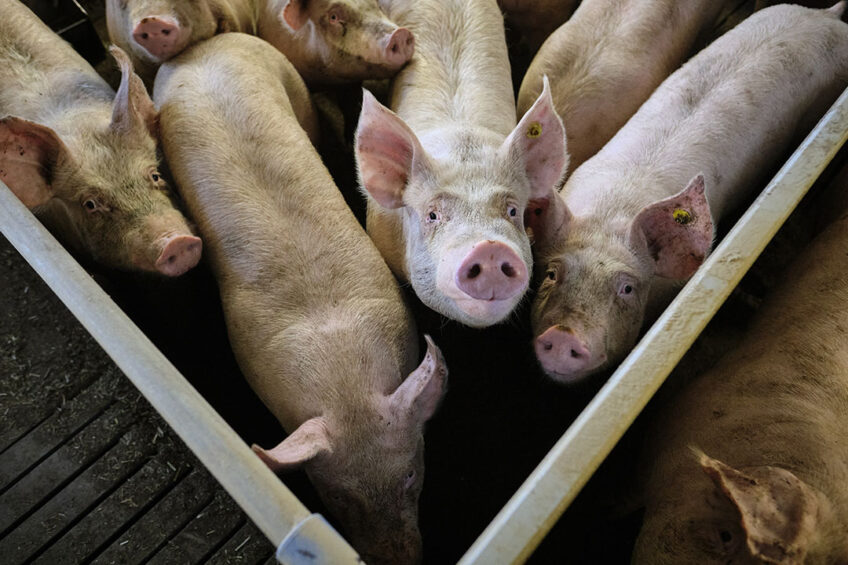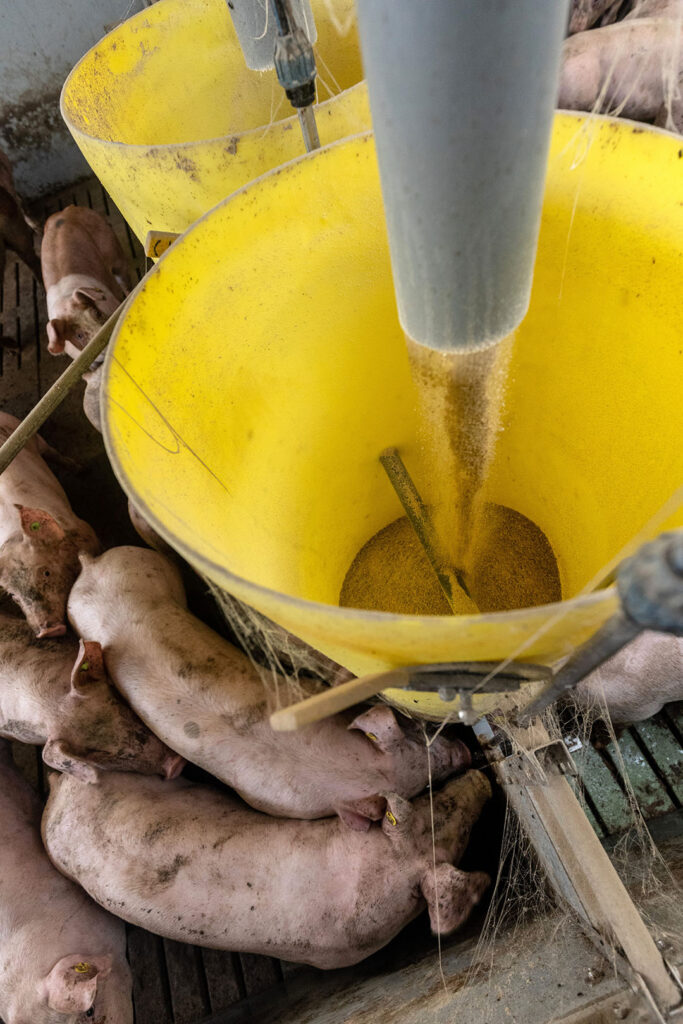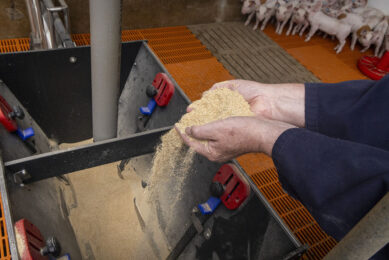Selection for feed efficiency

Feed is one of the largest costs in pork production; therefore, improving feed efficiency and lean accretion can increase producer profitability.
Genetically selective breeding for RFI
Improved feed efficiency can support industry competitiveness, reduce the demand on global feed resources, and complement environmental sustainability. Genetically, selective breeding for residual feed intake shows promise in meeting these increased demands. On the other hand, selection for improved residual feed intake is controversial from a welfare standpoint, given that the genetic variation in residual feed intake reflects the genetic variation in activity, performance and response to stress. Therefore, it is important to balance the benefits of selection for improved feed efficiency with pig performance, physiological, immunological, and behavioural stress response, and welfare.
What is residual feed intake?
Residual feed intake is one method of measuring feed efficiency, and it is defined as the difference between a pig’s observed and expected feed intake. Pigs that consume less feed than expected have a lower residual feed intake, are more feed efficient, and they are therefore economically better for lean production compared to pigs with high residual feed intake. Factors that contribute to variation in residual feed intake are the same as those that affect feed efficiency, energy used during activity, efficiency of digestion, metabolic balance, thermoregulation, and temperament.
Pigs selected for improved feed efficiency
Selection for increased feed efficiency results in a trend towards reduced activity. More feed efficient pigs have fewer and shorter freezing bouts and fewer escape attempts than less feed-efficient pigs during novel testing. More feed-efficient pigs consume 20% less feed, they have greater live weight, greater fat free lean, greater loin depth, less backfat and 8% -12% greater feed efficiency than less feed-efficient pigs. Loin chops from more feed efficient pigs have less marbling than loin chops from less feed efficient pigs. The digestibility of dry matter, nitrogen and gross energy are higher in more feed efficient compared to less feed efficient pigs. Moreover, selection for improved feed efficiency alters feeding behaviour. Therefore, it is expected that in a production environment, these pigs would adapt quickly to feeding competition.
Physiological stress response
More feed efficient pigs indicate an increase in antioxidant defences and potential modifications of metabolic pathways leading to oxidative stress, metabolism, and cellular repair. More feed-efficient pigs may be less prone to muscular oxidative stress, and the liver may have a greater metabolic capacity when compared to their less feed-efficient contemporaries. More feed-efficient pigs have lower baseline stress, or lower response to a stress challenge; in addition, they tend to have lower baseline cortisol and lower cortisol concentrations in response to stress.

Immunological stress response
Genetic selection for improved feed efficiency does not affect the sickness behaviours expressed by pigs. After they have been infected with porcine reproductive and respiratory syndrome virus (PRRSV), more feed-efficient pigs tend to have lower levels of viremia in blood, a faster antibody response, and a greater increase in antibody levels. The growth rate of more feed-efficient pigs is less effected by infection than less feed-efficient pigs. More feed- efficient pigs show greater reduction in apparent faecal digestibility of crude protein as a result of immune system stimulation than less feed-efficient pigs. Genetic selection for feed efficiency increases the apparent faecal digestibility of nutrients. It also reduces the total tract digestive capacity of growing pigs during immune system stimulation.
Behavioural stress response
More feed-efficient pigs have lower lesion scores and become less active after placement. Novel object and human-approach tests are commonly used to test a pig’s behavioural response to fear eliciting stimuli as pigs are innately neophobic. During both novel objectu- and human-approach tests, more feed-efficient pigs express fewer fear behaviours than less feed efficient pigs. In addition, within a genetic selection programme for improved feed efficiency and lean accretion, there are no negative behavioural metrics that conclusively affect performance measures of pigs during the grow-finish period.
Concluding remarks
Studies conducted on residual feed intake are encouraging as they relate to physiological, immunological, and behavioural stress responses and performance of pigs that have been selected for improved feed efficiency. Selection for feed efficiency does not reduce the pig’s ability to respond to physiological, immunological, and behavioural stressors. One the contrary, pigs selected for feed efficiency are better able to cope with these stressors. Therefore, it is predicted that in a production environment, these pigs would be more robust when exposed to stressors. Although the exact mechanisms behind these findings are unknown, it is hypothesised that more efficient pigs are better able to direct resources where they are needed, to deal with the challenge and then go back to performing. More feed-efficient pigs are less affected by porcine reproductive and respiratory syndrome virus infection and inflammatory challenge and respond better to the disease. More feed-efficient pigs have a better lesion score on the day of placement, and fewer fear behaviours, which may be a useful tool to use in a selection programme. Therefore, it is anticipated that when producers walk grow-finish pens, more feed-efficient pigs will be less likely to touch the producer but will also be less stressed with the producer in their pen. More feed-efficient pigs are more efficient during the nursery and grow-finish phases and require less maintenance but need to be combined with selection for increased growth rate for it to be practical. To further ascertain the robustness of more feed-efficient pigs, more work is needed to evaluate their performance and stress response in commercial situations.
References are available from the author upon request
 Beheer
Beheer











 WP Admin
WP Admin  Bewerk bericht
Bewerk bericht